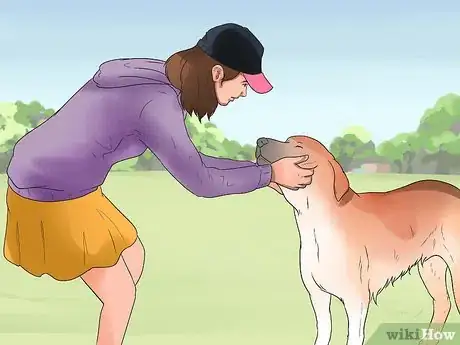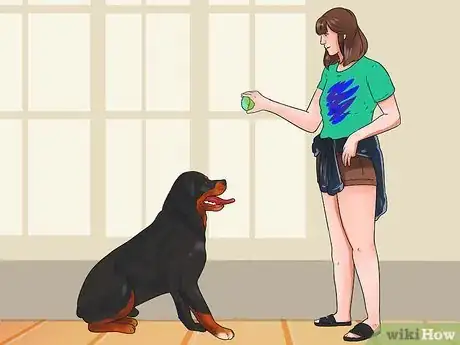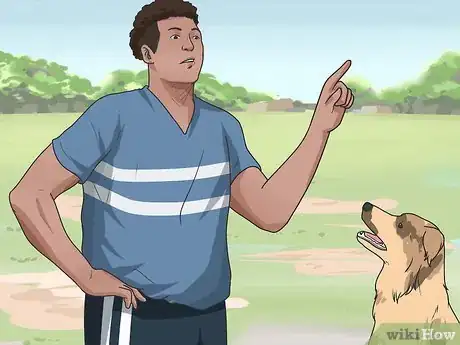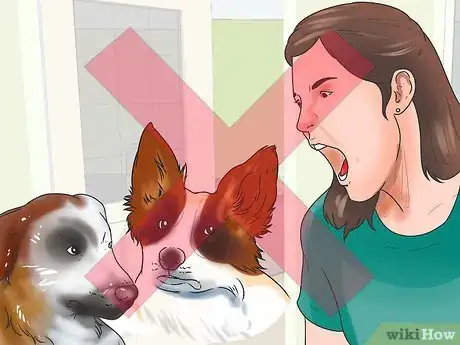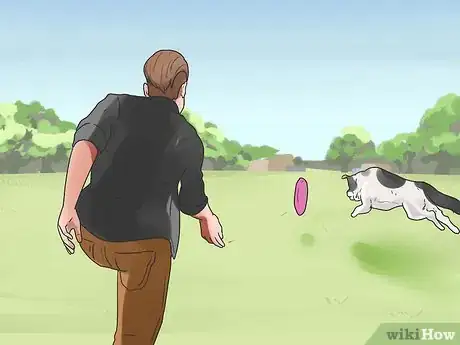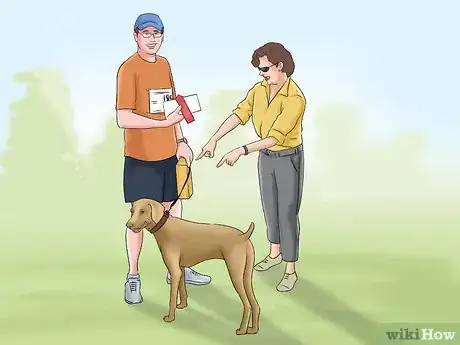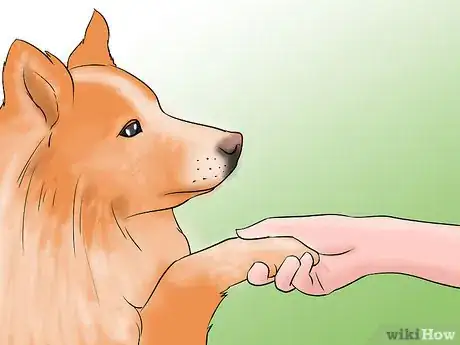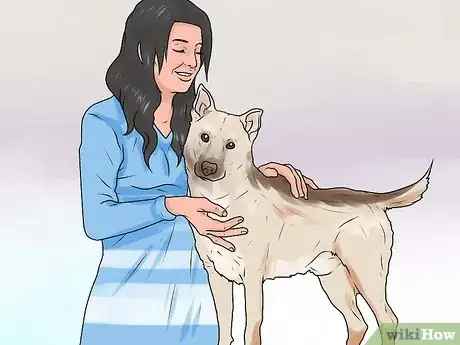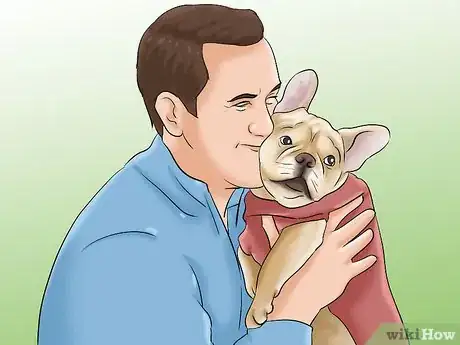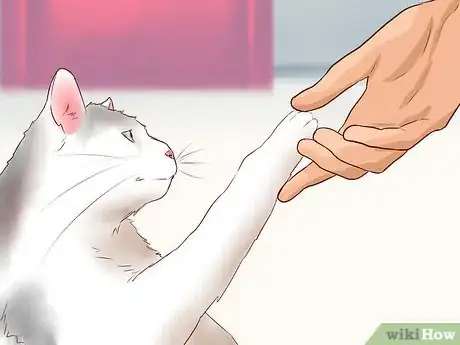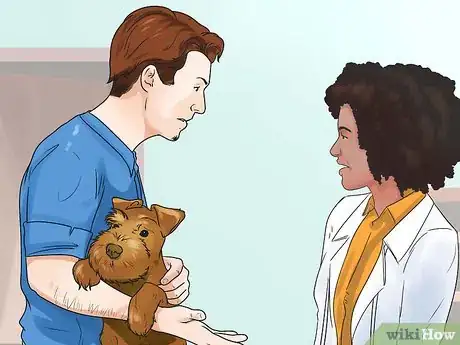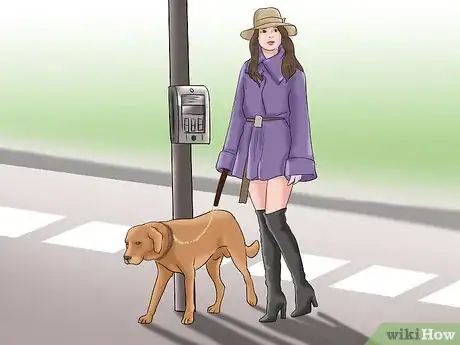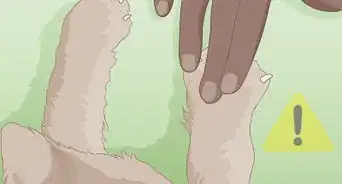This article was co-authored by Indigo Will. Indigo Will is a Canine Expert, Trainer, and Founder and Owner of K9-INDIGO® Holistic Dog Training LLC™, a dog training service in Los Angeles, California. Indigo specializes in understanding canine temperament and dispositions to allow canines to reach their full potential. He has studied various methods of training and philosophies to develop a unique, innovative, and result-driven method for canine behavior training.
This article has been viewed 67,049 times.
Living with an animal is a lot like living with a human friend: it's important to set clear boundaries, treat each other with respect, acknowledge one another’s needs, and spend quality time together. Unlike living with a human friend, however, your pet depends on you for food, health, care and affection, among other things. The specific ways in which you become friends with your pet will differ depending on what sort of animal you have.
Steps
Establishing Confidence
-
1Be calm. This one is pretty self-explanatory. Breathe regularly, make your movements smooth and slow (though not so slow that they look abnormal, as this will also freak some animals out), and speak in a calm, normal voice. Avoid being loud.
- Just think how you would feel if someone seemed to be nervous around you, was fidgeting a lot and speaking loudly and nervously, and making quick, jerky movements. This would make most people feel at least a little nervous — it’s the same for animals.
- Try to always be calm when dealing with your pets, no matter what they’ve done. If you’re very upset at them, take a moment to calm yourself down before dealing with them. You want them to respect you, not fear you.
-
2Be patient. Realize that it could take some time to build a lasting bond with your pet. Some animals, like puppies and kittens, might naturally be more easy around you than smaller mammals and reptiles, who might be more prone to defensive behavior.[1]
- If your pet doesn’t warm up to you right away, give it time. With consistent, kind, respectful behavior, and the appropriate use of treats, you should be able to win it over.
Advertisement -
3Be consistent. Be consistent in everything you do, from feeding to training, and everything in between. Pets are like children in that they need consistency and structure in order to feel safe and secure.[2]
- When they know what they can expect from you, your pets are more likely to feel comfortable around you (unless what they can expect from you is unpredictable, aggressive behavior … which they won’t like).
-
4Be the boss. Set rules and boundaries, and stick to them. Set aside time to practice these rules and boundaries with your pet each day. If your pet breaks a rule, use body language and calm but firm words to let them know that what they have done is not okay. Once you’ve established that you’re the boss, it’s okay to be more soft and loving with them, while still consistently enforcing the rules.
- With dogs they call this being the “alpha dog.” Dogs are happiest when they have confidence that you are their leader and can make decisions for them. They can then have freedom off lead and with people, other animals and in strange situations because they look to you for guidance and you pass on confidence. It’s okay for you to feel that you are “friends” with your dog, but your dog needs to know that you are his leader.
- Cats can be less easy to control, as they often like being the alpha. If your cat bullies you (often attacking you or ignoring your rules), a good way to train it is to simply ignore it when it does bad things, and praise it when it does things that you approve of. Cats might not like being controlled, but they like being ignored even less.
- Food is a good way to establish that you’re the boss. Most animals will notice that you’re the one that feeds them every day, which will make them look forward to seeing you. If you give them treats when they do something good, they’ll want to make you happy.
-
5Never use violent actions or language to communicate your displeasure with your pet. If your pet does something you disapprove of, calmly and firmly let them know it’s not okay without physically hurting them or screaming at them. Hurting them will make them more likely to attack you, not obey you.
-
6Understand your pet’s body language. Body language is vastly different depending on what sort of animal you have chosen for your pet. If you’re unsure of your pet’s body language, consider buying a book or reading some websites devoted to your specific animal. Understanding your pet’s body language will help you to be a better communicator, as you can even mimic some of their stances, expressions and sounds to send your message in a way they understand.[3]
- When dogs feel stressed out or threatened, their eyes will look larger than normal. If your dog is not feeling well, it might look as though it’s squinting. If your dog isn’t looking directly at you, but is looking out of the corners of its eyes so that you see a lot of the whites of the eyes (this is called “whale eyes”), he might be about to have an aggressive outburst. If your dog is feeling stressed or aggressive, its wide eyes will be accompanied by a rigid body.[4]
- If your cat looks at you and blinks at you slowly, it’s likely communicating affection. You can do this back at your cat to show your love, too. For cats, closing one’s eyes in the presence of another is a way to show trust. If your cat feels threatened, its tail will likely be upright and poofy (looking like the end of a toilet brush); its back will likely be arched, too.[5]
- Birds can be quite expressive through their eyes, feathers, and voices. If your bird’s pupils enlarge and shrink rapidly, this can be a sign that they’re excited or greatly interested, or scared or angry — context is important in telling which emotion it might be. Birds will ruffle their feathers while cleaning themselves; if their feathers remain ruffled, however, this could mean they’re unwell (in which case, take them to a vet for a checkup).[6]
-
7Respect your pet’s likes and dislikes. Animal experts give us general guidelines about what to expect from animals, but as with people, most animals will have their own quirks. It’s important that you respect your pet’s individuality; don’t try to make it do things that it clearly doesn’t like. Note that this isn’t the same as letting your pet run your house or bully you. You still need to consistently stand by your rules and boundaries.[7]
- Dogs are generally known to be affectionate and to want to be close to their owners at all times. Some dogs, though (and Shiba Inus are known for this), prefer not to be petted or cuddled. If your dog seems to dislike being petted, don’t force it. Maybe it likes to have an hour of alone time in another room of the house each night. As long as it’s not chewing on your furniture or digging a hole in the carpet, let it have its alone time.
- It’s not a bad idea to think of cats as weird roommates instead of animals. One minute your cat might be all over you and very affectionate, and within seconds it might jump off of you and run away, not to be seen for several hours. As long as it isn’t hurting you or your home, accept the quirk and let it be its own “person.”
-
8See the world through your pet’s eyes. Be empathetic when dealing with your pet. You don’t know what’s going on in its mind, so it’s best to try to read its body language and try to imagine what it must be going through so that you can treat it as well as possible.
- A rescue dog may have been abused by its previous owner. It may have spent most of its life before meeting you living on the streets, starving and scared. There is a lot of evidence (countless rescue stories and videos online) that proves these dogs, who may lash out at first, come around to love and trust their humans, and vice versa. If your dog is behaving in ways that you dislike, calmly, gently, and consistently reinforce the rules, and they will come around.
- If your pet is a small mammal (rat, gerbil, guinea pig, rabbit), don’t swoop down on them suddenly and pick them up, and then be surprised when they seem terrified. These are animals who are commonly preyed upon from above, so if you want to gain their trust and affection, it’s best not to behave like a predator.
Spending Quality Time Together
-
1Play together. If you can’t directly play with your pet, learn how your pet likes to play (or how their specific breed/species plays/acts.) and do your best to enable them to do so — whether it’s with you or merely in your presence.[8]
- This is may be easier to do with a cat or dog, as they both play in ways that are more familiar to human beings: throwing a ball around, chasing one another (playing tag), running and jumping.
- Some snakes enjoy climbing. If you want to feel more of a bond with your pet snake, and you feel safe letting it out of its enclosure, consider getting it a large climbing post and allowing it to do that as you work out. That way, you can feel as though you’re being active together. If you do this regularly, it can begin to feel like a routine.
- You can buy play gyms for birds. Put your bird on its play gym on your floor or table in the room with you while you work, read, exercise or watch TV, and allow the bird to play.
-
2Have adventures together. Take your dog on a hike somewhere it’s never been; go for a walk with your iguana or snake on your shoulder or arm (if it’s social); bring home a new toy and play with your cat. Animals get bored too; introducing fun new things into their lives now and then will make them happy. Just be smart about what you introduce: most cats wouldn’t enjoy going to a dog park, for example.
-
3Teach your pet new things. Many different animals enjoy learning tricks to earn rewards such as food or toys. Teach your dog or cat some new tricks, or sing a song and dance with your bird (it will likely learn to bob along with you if you bounce up and down in front of it). Set up an obstacle course for your pet rat and reward it for completing the course.
-
4Hang out with your pet. Literally just be in the same room with them. Let them be near you while you make dinner, watch TV, or read a book. The more you’re around one another, the better chances you have of becoming friends.
- Many snake owners say that their snakes enjoy wrapping around their arms or necks while they sit on the couch or go for walks (or even drive). Of course, if you’re not sure whether your snake is cuddling you or trying to strangle you, it’s probably better not to wear it around your neck.
-
5Show affection to your pet. If your pet is receptive to physical affection, provide it. Cuddle up on the couch with your cat, dog, reptile, bird, etc.
-
6Talk to your pet. Sure, they probably won’t understand most of what you say, but if you’re talking to them in a calm and positive way, it will help them get used to your presence and your voice. When you come home, be sure to say hello to your pet. This will help it associate you coming in the door with saying “hello.”
-
7Don’t leave your pet alone for long periods of time. How long your pet can go without you will depend on the animal. Cats and reptiles can go longer without their humans than dogs can, for example.
- If you know you’ll be away for 24 hours and you have a dog at home, arrange for someone to come and stay with your dog while you're gone. If you have a cat, it’s probably enough to leave some extra food and water out and, if your cat is particularly anxious, you might have someone the cat knows come in and spend an hour or two with them.
- If you are going away on vacation and cannot bring your pet, ensure that you find them appropriate and reputable care before you go.
- If you are regularly away from home for more than 5 hours a day, you might consider dropping your dog off at doggy daycare or seeing if you can bring him/her to work with you.
-
8Regularly acknowledge your pet’s presence. A pet is only part of your life, but for them, you are their whole life. That’s why it’s important to acknowledge your pet when you’re in the same room. Don’t ignore them. Act happy to see them. How you show your pleasure in seeing them will depend on what type of pet it is.
- A dog will generally enjoy a happy “Hello” and a pat when you walk past it.
- A cat might only want a hello, or it might want you to bend down and give it a little pat too.
- A guinea pig might squeak happily when you come near. If it enjoys being petted, say “Hello” and give it a little pet.
- A reptile that likes to be touched will be happy for the attention; but one that does not like to be touched, might not really care what you do … still, if you want to build a friendship with this animal, you’ll want to give it some sort of attention, even if it’s just walking up to its enclosure and saying “Hello.”
Taking Care of Your Pet
-
1Make sure you can afford a pet before getting one. Animals are living, long-term responsibilities; it is imperative that you ensure you can afford to feed and care for them. Make a monthly budget that includes food, supplies, and regular vet visits, and add a contingency fund for possible vet visits should your animal become ill. You might also consider buying pet insurance.
- Some things a dog needs: food, poop bags (if you live somewhere that requires you to pick up its waste), treats, a kennel, a good-quality leash and halter, a collar, an ID tag, a license (depending on where you live, you will likely need to license your dog with the city), toys, food and water bowls, and possibly a raincoat and booties (depending on the dog and where you live).
- Things cats need: litter boxes, litter, toys, food, food and water bowls, beds, carrying cases should they need to go to the vet, scratch posts, and treats.
- Things small mammals need: cages, cage filler, things to keep them busy in those cages (a wheel, some tubes and other toys), food and water supplies, and possibly a salt lick.
-
2Provide your pet with fresh food and water. Do this every day, at consistent times throughout the day (eg., morning and night). The key with all animals is to be consistent, as a lack of order in their lives can make them feel insecure and anxious, if not afraid.
- How often you feed your pets will depend upon what sort of animal they are: cats and dogs need to be fed at least twice a day; young and small adult lizards need to be fed several times a day, while other lizards and snakes only need to eat every other day or so.
-
3Buy high-quality food. Find out what the best-quality food for your type of animal is, and buy it. For cats and dogs, seek out foods that contain healthy, natural ingredients and as few preservatives as possible; for reptiles you’ll likely feed them whole foods such as plants, fish, or mice (depending on whether your pet is an omnivorous or carnivorous reptile).[9]
- Generally you can find a good selection of high-quality food at your local pet store or vet. If you have any doubts about the best diet for your pet, read up on the species or ask your vet.
-
4Keep your pet’s living space clean. Clean your dog’s kennel, your cat’s litter box, your rabbit’s cage, your snake’s enclosure etc. regularly. Avoid cleaning these spaces with harsh chemicals, as they can irritate your pet’s skin (or worse).
- It’s also important to keep your house — particularly your floors — clean. Don’t leave dangerous things lying around your house that might hurt your pet. Things like chocolate and grapes on the floor can be fatal for your dog; wires might be enticing for chewing, and could electrocute your pet.
-
5Ensure that your pet is well-groomed. Many pets groom themselves, but sometimes they might need some help. Dogs and cats can benefit from being brushed out regularly, particularly if they have long fur that’s prone to matting. If you have an outdoor pet and ticks are common in your area, regularly check for ticks and remove them.
- While it’s common to bathe a dog, bathing a cat isn’t actually necessary; in fact, it can do more harm than good, as it removes the natural oils on your cat’s coat. If your cat is particularly filthy or seems to be having trouble reaching certain parts of its body, it’s okay to help it along with a bath.
- If you do bathe your pet, ensure that you use something that is designed specifically for that animal. Never use human shampoo and conditioner for your dog or cat, or any other animal, as it can irritate their skin.
-
6Take your pet for regular vet checkups. Animals are quite good at hiding their illnesses; appearing healthy helps them survive in the wild, as sick animals are targets for predators. In addition, animals communicate differently than we do: instead of saying “I’m sick” your cat might stop eating, or it might start going to the bathroom outside of its litter box.[10] For these reasons, it’s best practice to schedule regular checkups for your pet at least once per year, even if it seems totally healthy.[11]
- Your pet will benefit from regular checkups more often than once a year as it moves into its senior years. Aim for at least twice a year when your pet is a senior.
-
7Socialize your pets. Exactly how and how often you socialize your pet will depend upon what animal you have.
- Dogs can be socialized every day with both people and other dogs; for a healthy dog, the opportunity to play with dog friends should be a source of happiness and relaxation. If your dog has anxiety about other dogs, however, you’ll need to be more careful about how you socialize him/her.
- Cats are more likely to enjoy being socialized with people than other cats, as they can be quite territorial. That said, if your cat seems to enjoy the company of other cats, there’s not reason not to have kitty dates with friends. Generally this will apply more to indoor cats than outdoor ones.
- Some small mammals and birds can benefit from the company of a friend — particularly if you’re away from home a lot.
-
8Ensure that your pet gets enough exercise. How often your pet needs exercise, and what sort of exercise it needs, will depend on the animal. There will even be variations within the same animals, depending on their type, general fitness, and age. If your pet doesn’t get enough exercise, it will be more likely to misbehave or be aggressive.[12]
- Walk and play with your dog every day. How long and strenuous your exercise with your dog is will depend on the breed: a husky will need much more exercise than a pug.
- Play with your cat every day. Cats are generally quite active and good at making their own fun, but if you want to bond with your cat, you’ll need to become part of their daily activities. Pull a string around the house and let them chase it, or wave a peacock feather around and let them try to catch it.
-
9Create a safe space for your pet. Your pet can go to its safe place when it feels scared or upset. Do not send your pet to this space when you’re upset with it, as doing so will make it a place of punishment rather than a safe place where your pet can go relax.
- For a dog, a safe space could be a large kennel with some warm blankets and a toy inside, or a nice dog bed in the corner of the room.
- For a cat, this might be a bed at the top of a scratch post, or a little covered soft cat house.
- For a fish, a reptile, or a small mammal, this might be a tunnel-like or otherwise enclosed structure into which they can run and hide if they feel afraid.
Expert Q&A
-
QuestionCan an animal be your friend? Do they see it that way?
 Indigo WillIndigo Will is a Canine Expert, Trainer, and Founder and Owner of K9-INDIGO® Holistic Dog Training LLC™, a dog training service in Los Angeles, California. Indigo specializes in understanding canine temperament and dispositions to allow canines to reach their full potential. He has studied various methods of training and philosophies to develop a unique, innovative, and result-driven method for canine behavior training.
Indigo WillIndigo Will is a Canine Expert, Trainer, and Founder and Owner of K9-INDIGO® Holistic Dog Training LLC™, a dog training service in Los Angeles, California. Indigo specializes in understanding canine temperament and dispositions to allow canines to reach their full potential. He has studied various methods of training and philosophies to develop a unique, innovative, and result-driven method for canine behavior training.
Professional Canine Expert Certain pets, like dogs, will absolutely 100% bond with you. If you establish rapport with your pet and you feel like you're friends, then who's to say otherwise!
Certain pets, like dogs, will absolutely 100% bond with you. If you establish rapport with your pet and you feel like you're friends, then who's to say otherwise! -
QuestionHow can I make my dog happy when I have to crate them?
 Indigo WillIndigo Will is a Canine Expert, Trainer, and Founder and Owner of K9-INDIGO® Holistic Dog Training LLC™, a dog training service in Los Angeles, California. Indigo specializes in understanding canine temperament and dispositions to allow canines to reach their full potential. He has studied various methods of training and philosophies to develop a unique, innovative, and result-driven method for canine behavior training.
Indigo WillIndigo Will is a Canine Expert, Trainer, and Founder and Owner of K9-INDIGO® Holistic Dog Training LLC™, a dog training service in Los Angeles, California. Indigo specializes in understanding canine temperament and dispositions to allow canines to reach their full potential. He has studied various methods of training and philosophies to develop a unique, innovative, and result-driven method for canine behavior training.
Professional Canine Expert Make it a fun experience for them! Play with them while they're in (or near) the crate. Give them treats and just maintain a friendly and happy demeanor. They won't be too stressed out, and eventually, they may even look forward to crate time!
Make it a fun experience for them! Play with them while they're in (or near) the crate. Give them treats and just maintain a friendly and happy demeanor. They won't be too stressed out, and eventually, they may even look forward to crate time! -
QuestionWhat if my new pet tries to eat my old pet?
 icecreammia3Community AnswerYou need to separate them immediately. It really depends what kind of pets they are. If they are two dwarf hamsters in the same cage, for example, they will fight. Do a little research and see what you can find out. It's always best to introduce pets in short periods of time first so they can get used to each other.
icecreammia3Community AnswerYou need to separate them immediately. It really depends what kind of pets they are. If they are two dwarf hamsters in the same cage, for example, they will fight. Do a little research and see what you can find out. It's always best to introduce pets in short periods of time first so they can get used to each other.
Warnings
- While treats are a great tool for training your pets, be careful not to give them too many treats, as you do not want them to gain weight and become unhealthy. Also ensure that you buy high-quality, healthy treats (not the equivalent of a chocolate bar for your pet).⧼thumbs_response⧽
References
- ↑ Indigo Will. Professional Canine Expert. Expert Interview. 8 September 2020.
- ↑ Indigo Will. Professional Canine Expert. Expert Interview. 8 September 2020.
- ↑ Indigo Will. Professional Canine Expert. Expert Interview. 8 September 2020.
- ↑ https://www.aspca.org/pet-care/virtual-pet-behaviorist/dog-behavior/canine-body-language
- ↑ http://pets.webmd.com/cats/features/cat-body-language
- ↑ http://www.peteducation.com/article.cfm?c=15+1795&aid=3334
- ↑ Indigo Will. Professional Canine Expert. Expert Interview. 8 September 2020.
- ↑ Indigo Will. Professional Canine Expert. Expert Interview. 8 September 2020.
- ↑ http://www.anapsid.org/feedingtips.html
- ↑ http://www.pethealthnetwork.com/cat-health/cat-checkups-preventive-care/how-tell-if-your-cats-secretly-sick
- ↑ Indigo Will. Professional Canine Expert. Expert Interview. 8 September 2020.
- ↑ Indigo Will. Professional Canine Expert. Expert Interview. 8 September 2020.
About This Article
To be best friends with your pet, spend quality time with it every day, which will help the two of you bond. You can play games together, go on adventures, and teach your pet tricks. Even just hanging out with your pet while you watch a movie or read on the couch can help you get closer to each other. When you're hanging out with your pet, show it affection by petting it, giving it treats, and talking to it so it learns to trust and love you. Besides bonding with your pet, make sure you're taking care of all of its needs by giving it food, water, and exercise so it doesn't feel neglected. For more tips, like how to understand your pet's body language, keep reading!
